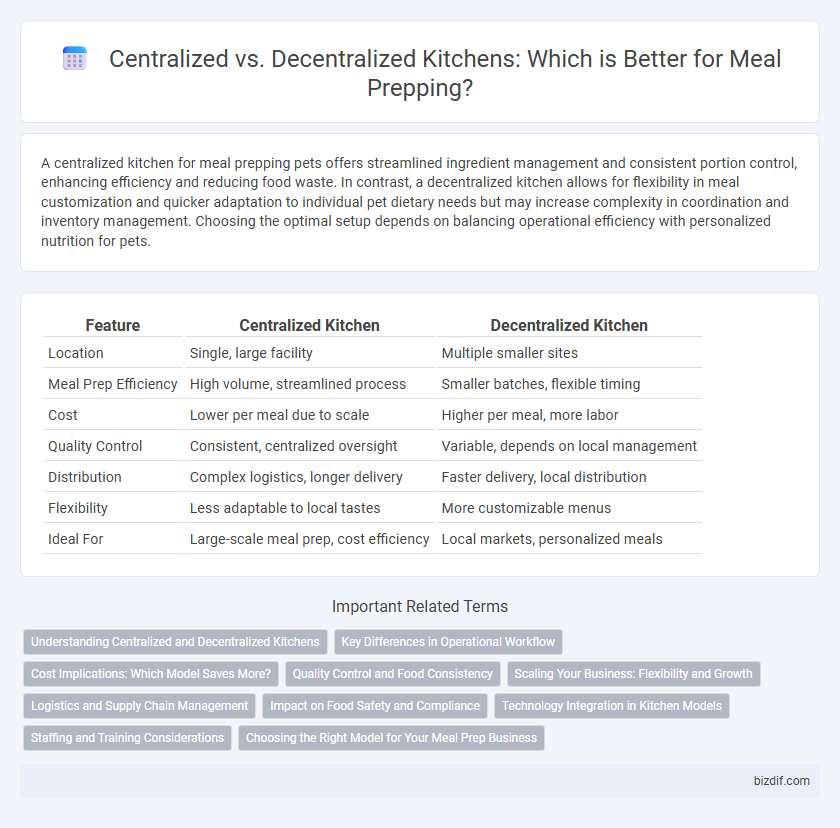A centralized kitchen for meal prepping pets offers streamlined ingredient management and consistent portion control, enhancing efficiency and reducing food waste. In contrast, a decentralized kitchen allows for flexibility in meal customization and quicker adaptation to individual pet dietary needs but may increase complexity in coordination and inventory management. Choosing the optimal setup depends on balancing operational efficiency with personalized nutrition for pets.
Table of Comparison
| Feature | Centralized Kitchen | Decentralized Kitchen |
|---|---|---|
| Location | Single, large facility | Multiple smaller sites |
| Meal Prep Efficiency | High volume, streamlined process | Smaller batches, flexible timing |
| Cost | Lower per meal due to scale | Higher per meal, more labor |
| Quality Control | Consistent, centralized oversight | Variable, depends on local management |
| Distribution | Complex logistics, longer delivery | Faster delivery, local distribution |
| Flexibility | Less adaptable to local tastes | More customizable menus |
| Ideal For | Large-scale meal prep, cost efficiency | Local markets, personalized meals |
Understanding Centralized and Decentralized Kitchens
Centralized kitchens streamline meal prepping by consolidating cooking and preparation activities in one location, enhancing efficiency and quality control. Decentralized kitchens distribute food preparation across multiple sites, offering flexibility and localized customization but requiring robust coordination. Choosing between centralized and decentralized kitchens depends on factors like scale, menu complexity, and delivery logistics in meal prep operations.
Key Differences in Operational Workflow
Centralized kitchens streamline meal prepping by consolidating cooking, packaging, and distribution in one location, enhancing efficiency and consistency in operational workflow. Decentralized kitchens distribute these tasks across multiple sites, offering flexibility but often facing challenges in maintaining uniform quality and coordination. Centralized models prioritize scale and standardization, whereas decentralized setups emphasize localized customization and faster delivery.
Cost Implications: Which Model Saves More?
Centralized kitchens typically save on costs through bulk purchasing, streamlined labor, and reduced equipment redundancy, making them more efficient for large-scale meal prepping operations. Decentralized kitchens, while offering flexibility and faster delivery times, often incur higher expenses due to duplicated resources and increased logistical complexity. For businesses prioritizing cost savings in meal prepping, centralized kitchen models generally present a more economical solution.
Quality Control and Food Consistency
Centralized kitchens enable stringent quality control by standardizing cooking processes and using uniform equipment, ensuring consistent food texture and flavor across all meal prep batches. Decentralized kitchens face challenges in maintaining uniformity due to variability in staff skills and kitchen environments, which can lead to inconsistencies in portion sizes and taste profiles. Investing in centralized kitchen operations significantly reduces quality variation, enhancing overall customer satisfaction in meal prepping services.
Scaling Your Business: Flexibility and Growth
Centralized kitchens offer streamlined operations and cost efficiencies ideal for scaling meal prep businesses, ensuring consistent quality and easier inventory management. Decentralized kitchens provide greater flexibility and faster delivery times by distributing production closer to target markets, supporting rapid expansion in diverse locations. Choosing the right kitchen model depends on balancing operational control with market responsiveness to optimize growth.
Logistics and Supply Chain Management
Centralized kitchens streamline logistics by consolidating meal preparation in one location, reducing transportation costs and improving inventory management through bulk procurement of ingredients. Decentralized kitchens, while increasing delivery speed and local customization, pose challenges such as higher supply chain complexity and fragmented inventory control. Efficient coordination in centralized systems enhances supply chain visibility, whereas decentralized models require robust communication networks to manage distributed logistics effectively.
Impact on Food Safety and Compliance
Centralized kitchens enhance food safety and compliance by consolidating operations into a single, controlled environment with standardized procedures and rigorous quality checks, reducing contamination risks. Decentralized kitchens, while offering flexibility and proximity to consumers, face greater challenges in maintaining consistent safety standards due to varied operational practices and localized inspections. Regulatory agencies often favor centralized models for meal prepping due to their streamlined oversight and higher traceability of food safety violations.
Technology Integration in Kitchen Models
Centralized kitchens leverage advanced automation systems and integrated inventory management software to streamline meal prepping and ensure consistent food quality across large-scale operations. Decentralized kitchens benefit from cloud-based platforms and IoT-enabled appliances that enhance real-time communication and flexibility, enabling rapid adaptation to local demand. Both models increasingly utilize AI-driven data analytics to optimize ingredient procurement and reduce food waste.
Staffing and Training Considerations
Centralized kitchens require a specialized, consistent team trained in standardized procedures to ensure efficiency and quality across meal prepping operations. Decentralized kitchens demand flexible staffing with versatile skills to adapt to varied local menus and cooking environments, often necessitating ongoing localized training. Investing in comprehensive training programs tailored to each model's specific workflow enhances productivity and maintains food safety standards effectively.
Choosing the Right Model for Your Meal Prep Business
Choosing the right kitchen model significantly impacts efficiency and scalability in a meal prep business. Centralized kitchens consolidate all cooking activities in one location, reducing overhead costs and streamlining quality control, while decentralized kitchens allow for localized production closer to customer bases, enhancing freshness and delivery speed. Evaluating factors like order volume, delivery range, and operational complexity guides the decision between centralized and decentralized setups to optimize workflow and customer satisfaction.
Centralized kitchen vs decentralized kitchen Infographic

 bizdif.com
bizdif.com